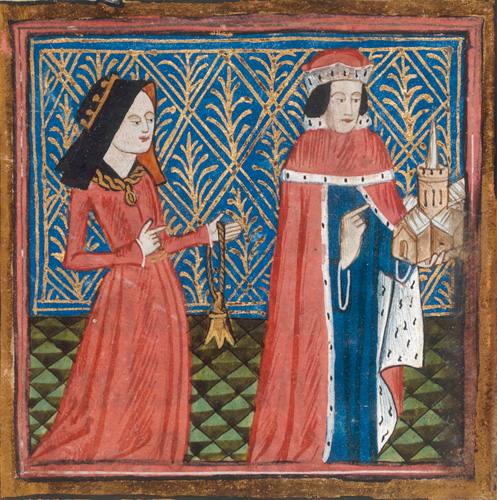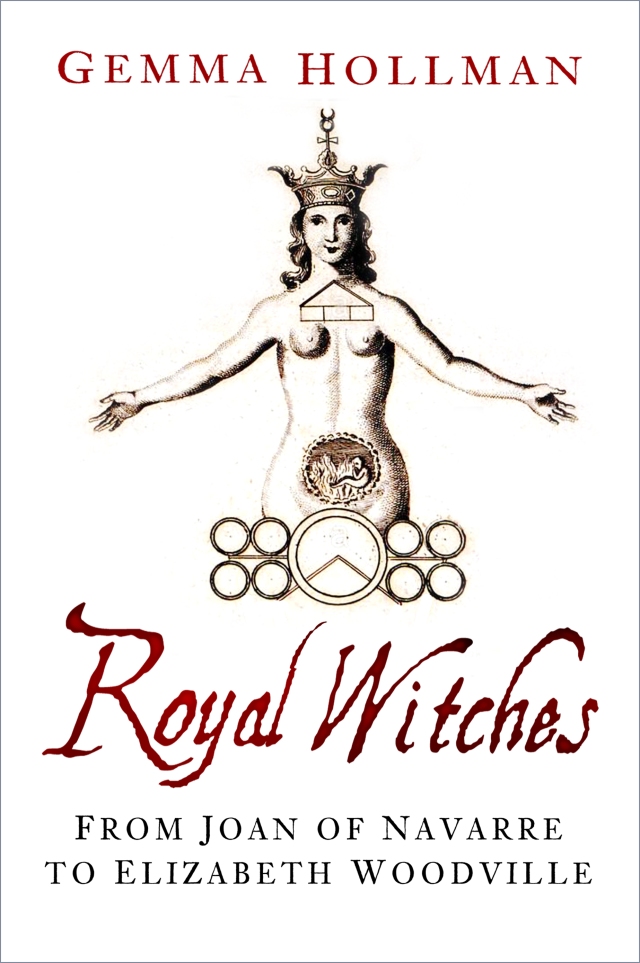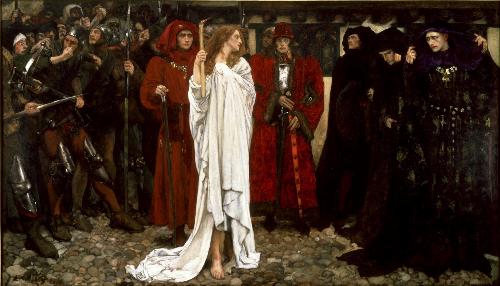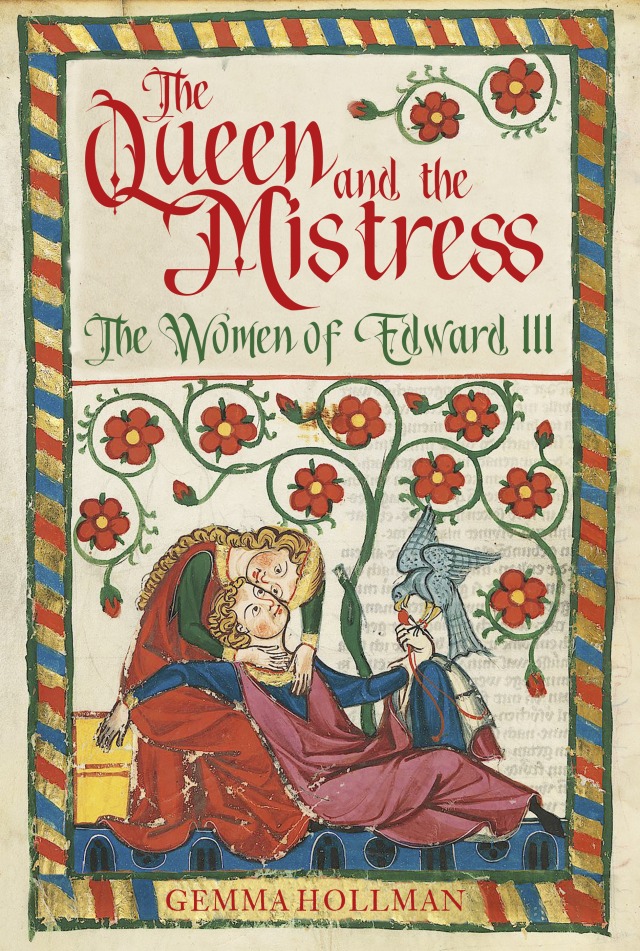I thought it only fitting to write my first post about one of the women my recent Masters dissertation focused upon. Eleanor Cobham was a woman who lived in England during the fifteenth century. In 1428, she married Humphrey, the Duke of Gloucester, who was one of Henry V’s brothers, and uncle to the current child king, Henry VI. This raised her to one of the highest positions in the land – something rather scandalous at the time, particularly owing to her comparatively lower status as the daughter of a knight and her previous position as Gloucester’s mistress. Her marriage with Gloucester was a great success, and from 1435 onwards – upon the death of Gloucester’s older brother the Duke of Bedford – her husband became heir to the throne of England (and sort of France… but that’s complicated and contentious!). This made Eleanor the highest ranking lady of the land, as Henry VI was unmarried. However, in 1441, Eleanor’s fortunes changed drastically when she became embroiled in accusations of witchcraft. It was alleged that she instigated several men of her household and a female witch to use witchcraft in order to procure the death of Henry VI. Her supposed motivation was to make her husband succeed to the throne, thus making her Queen. (2019 update: I have now written a book all about the accusations against Eleanor and other royal women this century, find it on Amazon here!)

Eleanor and her husband Gloucester joining the confraternity of St Albans, the Abbey of which (in Gloucester’s hand) Gloucester frequently patronised and spent part of his retirement at in the 1440s.
In August 1441, Eleanor had entered London in a marvellous display fitting of a princess, wearing splendid clothes and surrounded by lords of the land. Not long after, her personal clerk was put on display on a scaffold at St Paul’s Cross, an open area in front of St Paul’s Cathedral, surrounded by instruments of witchcraft. He was seated on a chair decorated with swords and images, wearing a paper crown, accompanied with images made of various materials. Here, in front of the Archbishop of Canterbury, senior bishops and clergymen, lords of the realm and the commons of the city, he admitted using malign magic to invoke the devil and other evil demons. Two days later, Eleanor fled to sanctuary in Westminster Cathedral.
In the meantime, her clerk, Roger Bolingbroke, was examined before the King’s Council, where he and others who had been arrested admitting using necromancy to conjure the dead in order to tell the future. They claimed this had been under Eleanor’s orders, so that she could find out if she would ever become a higher status. This suggested, to the Council, that she wanted to know whether Henry VI would die and her husband become King, thus making her Queen. They took this to be treasonous as they were worried that, as the accused had determined Henry VI would become seriously ill within a few months, they may be encouraged to ensure the prophecy came true by killing the King.
This was understandably extremely scandalous. It was not just that an attempt had been made against the King’s life, by sorcery no less, but that a woman as high status as Eleanor was involved. She was, after all, a member of the royal family. As Eleanor had shrewdly taken sanctuary, she was unable to be tried for treason by the lords of the King’s Council, no matter how hard they tried to extract her. However, the accusations of witchcraft against her came under ecclesiastical law, and so Eleanor was brought before bishops of the King’s Council and tried whilst in sanctuary. Although Eleanor initially protested her innocence, once Bolingbroke testified to the bishops in Eleanor’s presence, she admitted some of the charges against her. However, she claimed that she had never attempted sorcery against the King’s life; instead, she said that she had used the female witch, Margery Jourdemaine, to procure love magic to first induce Gloucester to marry her, and later have a child by him.
Two of the men implicated in the affair were sentenced to death, and Bolingbroke was hanged, drawn, and quartered. Whilst on the scaffold before his execution, he vehemently protested his innocence, saying he had never partaken in any sorcery. A third man was pardoned, whilst Margery Jourdemaine was burnt at the stake as a relapsed heretic, having previously been pardoned from using sorcery in 1431. Eleanor was divorced from Gloucester by the bishops, as her marriage was deemed to have been procured by witchcraft. She was also made to fulfil penance in London across three different days by walking bare headed through the streets with a burning candle in her hands, offering it at three different churches. After this was completed, she was put under the guardianship of Sir Thomas Stanley for life, and sent initially to Leeds Castle. She stayed imprisoned in various castles until her death in 1452.

Eleanor fulfilling her penance, as imagined by J.W.E. Doyle in an 1864 edition of A Chronicle of England.
At first glance, this seems like a scandalous moment in medieval English history, one of great gossip at the time, and of noteworthy interest to modern ears. The case is not as simple as this, however. There is not enough space in a post of this length to delve into great depth as to the overwhelmingly political motivations for Eleanor’s arrest, trial, and sentencing. However, it has become clear to modern historians that the accusations against Eleanor were in fact brought about out of a desire by men of the King’s Council to destroy her husband, the Duke of Gloucester, as a political player. By 1441, Gloucester was the heir to the throne, but his divisive actions across the last few decades had given him many powerful enemies at court This included the Cardinal Beaufort, a conspicuous figure present at all stages of Eleanor’s trial. Many wished to remove him from his great position of power, and destroy his influence over the still-young King Henry VI. Gloucester was too powerful to directly attack, as past experience had proven. However, the nature of medieval society meant that women had to safeguard their reputations – not only for themselves, but for the men around them. A man could be tainted by a misbehaving wife, having his own reputation damaged. By attacking Eleanor, a far weaker figure who commanded far less power, Gloucester’s enemies could destroy Gloucester’s reputation by association.

Enjoying this blog post? Buy me a hot chocolate!
Consider donating the cost of a hot chocolate to me, so I can continue to write and run Just History Posts.
£3.50
By successfully destroying Eleanor, Gloucester was indeed ruined for life. He didn’t return to politics until the following year, but by that point his power base was all but gone. By 1445, he was denied access to the court and was removed from the Privy Council. In 1447, it appears Henry VI had been convinced by men at court that Gloucester was making an attempt on his life in order to seize the Crown for himself and free his imprisoned wife. No doubt, the memory of Eleanor’s supposed actions led easy credence to these accusations in Henry’s mind. Consequently, Gloucester was arrested on his way to Parliament, and he died 3 days later. Many of his supporters and chroniclers believed Gloucester had been murdered, although historians seem to think he probably suffered a stroke. His enemies had been successful.
Eleanor’s case is an interesting example of the transferability of a women’s reputation in this period, and inherent weaknesses experienced by women at all levels of society. Even a woman in a position as high and protected as Eleanor should have been, as the highest lady of the land and wife to the heir to the throne, could not be saved from these accusations. Of course, there are multiple issues at play here that cannot even begin to be touched upon in this space (I did, after all, write a dissertation on it!). However, I hope this has been an interesting brief insight into one of the most scandalous events in fifteenth century England. If you are interested in learning more about Eleanor’s case, I have put a brief select bibliography at the end. You can also follow the blog’s twitter account, here, to keep up-to-date with future blog posts and any other pieces of interest. Update: Three years after writing this blog post, I have now published a book on Eleanor and three other royal women of her century who were accused of using witchcraft. If you want to learn more about Eleanor’s life and the accusations against her, then you can find my book on Amazon here.
List of Blog Posts: here Blog Homepage: here
Buy my books via the pictures below! Or why not check out our shop?

Follow us:
Primary
Hill, Richard. “Lament of the Duchess of Gloucester.” In Political Poems and Songs relating to English History, composed during the period from the accession of Edward III to that of Richard III. Volume 2, edited by Thomas Wright, 205-208. London: Longman, Green, Longman, and Roberts, 1861.
The Brut; or, The Chronicles of England, edited by Friedrich Brie. London: K. Paul, Trench, Trübner & Co. Limited, 1906. (pgs 478-482 are the main retelling)
Chronicles of London, edited by Charles Kingsford. Oxford: Clarendon Press, 1905. (pgs 149-157)
Secondary
Freeman, Jessica. “Sorcery at Court and Manor: Margery Jourdemayne, The Witch of Eye Next Westminster.” Journal of Medieval History 30, no. 4 (2004): 343-357.
Griffiths, Ralph. “The Trial of Eleanor Cobham: An Episode in the Fall of Duke Humphrey of Gloucester.” In King and Country: England and Wales in the Fifteenth Century, edited by Ralph Griffiths, 233-252. London: The Hambledon Press, 1991.
Kittredge, George Lyman. Witchcraft in Old and New England. New York: Russel & Russel, 1956.
Petrina, Alessandra. Cultural Politics in Fifteenth Century England: The Case of Humphrey, Duke of Gloucester. Brill: Brill Academic Publishers, 2004.
Vickers, K. H. Humphrey, Duke of Gloucester: A Biography. London: Archibald Constable and Company Limited, 1907.






Great stuff! Expecting more interesting and juicy articles like this in the near future! 🙂
LikeLiked by 1 person
Very interesting article. It reminded me of a even earlier (13C) Eleanor, Eleanor of Castile , beloved wife of Edward I about whom I have written.
https://ramblingwombat.wordpress.com/2017/03/04/eleanors-cross-at-charing/#more-4804
LikeLike
Yes, that Eleanor was also a fascinating and formidable woman, and one who I hope to write about one day! I look forwards to reading your piece on her
LikeLike
Don’t expect the detail and quality of your pieces !
LikeLike
It’s fascinating how many powerful women there were in mediaeval Europe, even if their power could not always be exercised in direct ways. Your blogs bring this out nicely. Will keep reading them!
LikeLike
Yes definitely! One of the things I love about doing medieval history is that many people don’t expect there to be so many strong women. Glad you enjoy them!
LikeLike